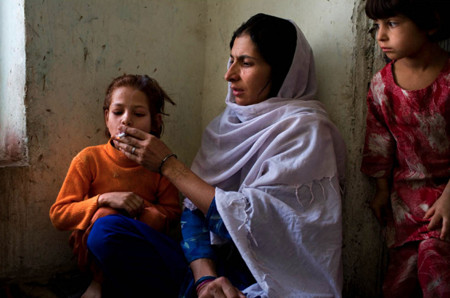By Ahmad Seyar Yazdani
Dirty and disheveled, 26-year-old Malalai lay surrounded by piles of rubbish under a bridge in central Kabul.
She had been a drug addict for two years, after friends introduced her to heroin. Six months ago, her family threw her out and she now spent her days under the Pol-e Sokhta bridge, a place where many of the city’s drug users congregate.
Malalai occasionally begged for money so that she could buy drugs from other users living under the bridge. After exchanging a few words with an IWPR reporter, she said in a weak voice, “Go away, leave me alone. Stop bothering me.”
When IWPR’s reporter returned a few days later to interview Malalai again, he was told she had died.
Addiction remains a serious problem in Afghanistan, the world’s top producer of opium and its refined product, heroin.
Sayed Jawid Badakhsh, head of addiction treatment at the Afghan health ministry, said recent research showed that 3.5 million people had substance abuse problems, amounting to 11 per cent of the population. Of the total, between 650,000 and 890,000 were women and 100,000 children.
Addiction treatment catering specifically for women is badly under-resourced.
“We have 108 centres that treat drug addiction in the country’s 34 provinces,” Badakhsh explained. “Of these, six centres are for female drug addicts, across six provinces.”
The Kabul centre can accommodate most patients with 80 beds, while the Balkh and Nangarhar clinics have 60 each. Badakhshan and Herat can treat 30 women at a time, while the rehab centre in Farah has just 20 beds, according to Badakhsh.
Parwez Rahimi, head of the legal section for women at the Afghanistan Independent Human Rights Commission (AIHRC), says the social impact of female addiction was particularly severe because of their role in the family.
“We have even encountered addicts who have sold their own children for money to buy drugs,” he said, adding that women were usually introduced to drugs by their husbands or other close family members.
Mohammad Usman Forotan, director of policy and planning at the counter-narcotics ministry, said poverty and high rates of unemployment were leading people to turn to drugs. Poppy eradication programmes and addiction treatment were only part of the solution, he said.
“We have launched awareness campaigns in the provinces. In addition, the harmful impact of drugs should be included in the educational curriculum, and we are working with the relevant ministries to introduce this,” he said.
Officials at the ministries of health and counter-narcotics agree that the main concern is unemployment. Even if drug addicts are successfully treated, they risk relapsing if they have no opportunity to find work.

Mother & Child: Secluded From Society, Afghan Women Use Hashish To Spend Long Hours at the Loom, and Frequently Feed the Drug to Their Children, too. (Photo: Flickr)
Matin Akbari, a specialist at the Ministry of Women’s Affairs, says many women turn to petty crime or prostitution to feed their habit. He is critical of his own ministry for failing to do enough about this.
“The women’s affairs has no plan to tackle the problem,” Akbari told IWPR.
Najibullah Danesh, a spokesman for the interior ministry, also said that addiction fueled crime.
“The police have arrested a number of female addicts who were involved in theft and pickpocketing,” he added.
He said the police had relocated 2,000 male and female addicts from Kabul to treatment centres outside the city, but warned that government agencies simply lacked the resources to treat all the country’s addicts.
The health ministry offers both treatment in residential clinics and an out-patient service for those struggling with addiction.
Home treatment involves a psychological assessment followed by mental health support for 45 days. The whole process can take up to six months, and according to the ministry, 400 people receive treatment at home every month across Afghanistan.
Afghans, particularly in more remote parts of the country, have traditionally used opium as a medicine. Decades of war have driven many to take heroin. The influx of returning refugees from neighbouring Iran, where addiction rates are high, has also fuelled the problem.
Despite high rates of addiction, government figures show that poppy cultivation is falling. According to Forotan, it fell by 19 per cent nationwide in 2015. A government survey revealed that 1,830 square hectares of land was planted with opium poppy this year compared with 2,240 in 2014.
Opium production fell by nearly half, from 6,400 tons last year to 3,300 in 2015.
The survey showed that most cultivation took place in areas where the government had less control, including southern and south-western provinces.
Despite official reports showing a decrease in cultivation, users in Kabul say accessing narcotics is child’s play.
Shah Pari, a user for the last three years, said, “Now we can find drugs easier than ever before. The dealers sell drugs openly to groups of addicts and in the market.”
Simin, a female addict, said it was her husband who first introduced her. After he began smoking drugs at home, he encouraged her to join him.
“I have been using drugs with my husband for the past seven years,” she said. “We have sold all our possessions. We have no way back from this path now.”
Ahmad Seyar Yazdani is an IWPR-trained journalist in Kabul.
This report was produced under IWPR’s Promoting Human Rights and Good Governance in Afghanistan initiative, funded by the European Union Delegation to Afghanistan.



